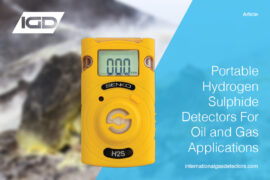Volatile organic compounds (VOCs) — chemicals that readily transform into gases at room temperature — are emitted from an array of products and processes. While many VOCs are considered harmless, including those naturally released in our breath, some VOCs warrant our attention due to their immediate threat to human health or indication that something is amiss.
Introducing VOC Monitors
Throughout the latter half of the 20th century, a series of instruments were invented to detect the presence of VOCs. Beginning as bulky systems that required highly-trained operators,. They gradually became smaller and easier to operate, due to the emergence of sophisticated technologies. Nowadays, a host of detection methods exist, utilising cutting-edge technologies such as electrochemical sensors, infrared sensors, and metal-oxide-semiconductor sensors. Notably, photoionization detectors (PIDs), which utilise high-energy UV light to identify airborne compounds, have become increasingly popular due to their ease of use, extreme sensitivity (detecting up to parts-per-billion), instantaneous readings and ability to be miniaturised in portable devices.
The Benefits of Portable VOC Monitors
While fixed VOC monitors are an effective measure when leaks or emissions are predictable and confined, the generation of portable VOC monitors, both hand-held and wearable, have expanded the versatility of VOC monitors. This has in turn transformed the safety and capability of many systems. For example, the ability to detect and then respond to flammable & toxic gas emissions, such as aromatic hydrocarbons produced from waste sites, acetone and dichloromethane as used in adhesive products, and butanone as used in plastics, textiles and cleaning agents make portable VOC monitors an indispensable tool for detecting for toxic VOC gases across a swathe of industries. As well as detecting unexpected leaks from faulty hardware, a portable VOC monitor can identify faulty fixed monitor systems. Portable VOC monitors also lend themselves to quantifying abatement plant efficiency inside and outside of a factory, thereby enabling a company to conform to regulations and guidelines. Serving to minimise waste gas production and damage control, portable VOC monitors not only detect problems early but prevent significant economic, energetic and employee costs.

Similarly, portable VOC monitors can be used in laboratory environments where dangerous agents are present to ensure the health and safety of staff. Unlike fixed monitors that are typically stationed in laboratories, portable VOC monitors can reveal the extent of a leak by moving the monitor outside of the range of the fixed unit. Furthermore, they can be brought into clean rooms to verify standards of cleanliness.
Portable VOC monitors also serve a critical role in safeguarding individuals in domestic and office environments. Indeed, they are particularly effective for monitoring indoor air quality where they can detect xylene, and toluene — commonly produced as “off gases” from building materials, domestic products and daily activities. These noxious VOCs are often associated with a range of health complaints such as respiratory disease, eye irritation, skin allergies and fatigue. Indeed, they are suspected to be a major contributor to “sick-building syndrome”, a suite of non-specific symptoms attributed to residing in a particular building. Upon detection of noxious VOCs, which are often undetectable by smell, individuals can be prompted to increase ventilation.
Applications abound for portable VOC monitors. Not only can they detect problems early and prevent detriment on a number of levels, portable VOC monitors represent a source of reassurance and confidence in the workplace. Contact a member of the International Gas Detectors team today if you would like to learn more.
References:
nhs.uk. Sick Building Syndrome. (2021).
https://www.nhs.uk/conditions/sick-building-syndrome/
Nur’aini, A. and Oh, I. (2020) Volatile organic compound gas sensors based on methylammonium lead iodide perovskite operating at room temperature. RSC Advances. https://doi.org/10.1039/c9ra10703g .
Shen, S., Yuan, L. and Zeng, S. (2009) An effort to test the embryotoxicity of benzene, toluene, xylene, and formaldehyde to murine embryonic stem cells using airborne exposure technique Embryotoxicity test with airborne exposure technique. Inhalation Toxicology. https://doi.org/10.1080/08958370802687493.




